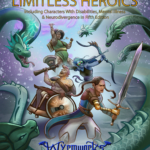Pain

You experience pain differently than most people. Choose or roll on the following table.
One thing I want others to understand about my experience with depression and chronic pain is that while I’m capable of doing most things that someone without my disabilities can do, the cost of my efforts on my energy levels and body are much greater than the other person. For example, walking three blocks feels like I walked a mile and a minor bump into a doorway feels like I was hit by a metal baseball bat.
– Heather Thomas
| d10 | Pain Experience |
|---|---|
| 1–5 | Chronic Pain |
| 6–9 | Hyperalgesia |
| 10 | Hypoalgesia |
- Chronic Pain. You experience chronic pain throughout your body. Any action that requires concentration (e.g., maintaining a spell) requires a successful DC 10 + (IE) Constitution saving throw per round to maintain concentration. Because you’re used to managing pain, even though this doesn’t reduce the experience of pain, you have a +(IE) bonus to saving throws against psychic damage.
- Hyperalgesia. You experience pain more intensely than most people. When you take physical damage, you also take (IE) × 5 percent psychic damage (minimum 1). Any rolls to maintain concentration also have a −(IE) penalty when taking damage. Because you’re used to managing pain, even though this doesn’t reduce the experience of pain, you have a +(IE) bonus to saving throws against psychic damage.
- Hypoalgesia. You experience less pain from injury than most people. On any day spent on at least mild activity, you must succeed on a DC 8 + (IE) Dexterity saving throw. On failure, you sustain a sore or wound that you’re unaware of. You must then succeed on a DC 8 + (IE) Wisdom (Perception) check to identify the wound so it can be treated. If you receive help on this check, you make the roll with advantage. If identified, a successful DC 5 + (IE) Wisdom (Medicine) check will allow the wound to heal. If the check fails, you sustain 1d(IE) damage per day until successfully treated. Because you do not feel pain the way most people do, you have resistance to psychic damage.
Real-world Examples
Anxiety, Neuropathy, Diabetes, Hereditary Sensory and Autonomic Neuropathy, Muscle Spasticity, Fibromyalgia, Myofascial Pain Syndrome, Polymyalgia Rheumatica
Assistive Options
Pain can be managed by avoiding the stimulus that triggers it or limiting physical exertion. Depending on the location and nature of the pain, using a cane, walker, or support hose can reduce the IE by 1. Relaxation techniques can reduce pain levels. If a short rest is used for a relaxation and stretching technique, the IE is reduced by 1 for 1d4 hours. Alternately, receiving a 1-hour massage will reduce the IE by 1 for 1 day. Hypoalgesia depends heavily on friends and allies helping to watch for wounds or irregularities as noted in the description.